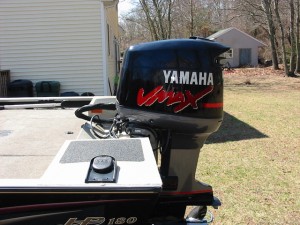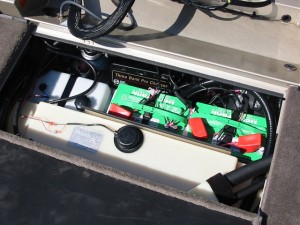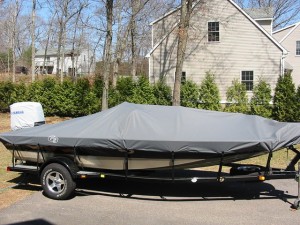
Winter Boat Maintenance
So… let’s wrap up the boat winterization series before we actually get deep into Winter!
We discussed maintaining our trailers at length in one of the previous posts, so we’ll leave that subject alone.
Let’s talk about winterizing the rest of the boat.
First of all, lets take a look at the batteries. These tend to get ignored or misunderstood when it comes to how to maintain them and store them.
Deep Cycle and Marine starting batteries need to be charged to 100% levels before being stored away for the winter. Batteries should never, ever be left outside during the winter months. Doing so will allow the battery acid to freeze and the battery will be useless afterward.
Once the batteries are fully charged they should be stored in an area that stays at least 45 – 50 degrees. Basements are ideal for this. Garages are good too, provided they stay above the required temperatures.
If you have batteries that aren’t maintenance-free, be sure that the water levels are topped off before you store them away.
Leaving the charger attached to your batteries isn’t a good idea if the charger doesn’t actually shut off completely when the batteries reach a full charge. Even if it is fully automatic, disconnecting it is still a good idea. If you’re worried about the batteries discharging while they sit, don’t worry about it. They won’t discharge. If you’re still worried about it, just connect a charger about half way through the Winter and bring it back up to full. In reality, if you do connect the charger half way through the winter, it will probably only charge for a few minutes before being back up to 100%.

Winter Battery Maintenance is important if you want your batteries to last
Oh, and one last thing about batteries. The old myth about not storing batteries on a cement floor is just that… a myth. Setting your batteries on cement floors will not discharge your batteries.
Now let’s look at the heart of winterizing your boat… the outboard and the fuel system.
I’m assuming that you already added fuel stabilizer to your gas tank way back in the late part of fall. If you didn’t, and the boat has been sitting idle for any longer than a few weeks, the gas is probably already starting to get stale. Add stabilizer anyway! You absolutely don’t want your fuel to go completely bad and cause gum to build up in your fuel system.
The absolute most important part of winterizing your boat is making sure the outboard has been fogged in preparation for the long idle time during the winter months. Fogging the motor protects the cylinder walls, pistons, carburetors and other internal parts from corrosion, which can be caused by condensation or any other kind of moisture that may occur. The fogging oil will also prevent problems with the carbs and injectors, keeping them from getting clogged or gummed up.
Fogging your outboard motor is a pretty basic procedure, but it will vary from one manufacturer to another and may even change from one size motor to another. Some outboards have special connectors built into them that allow a can of fogging oil to be screwed directly to the motor, while others require you to spray the fogging oil directly into the carburetors.
Either way, its critical to use enough fogging oil to be sure that the internal parts of the motor are fully protected. Do not take shortcuts in this area. Saving a few minutes or a few bucks now will cost you hundreds or even thousands of dollars down the road.
If you’re not sure how to do this, consult an authorized dealer and ask them for advice. If you’re not comfortable with doing it, pay an authorized dealer or service center to do it for you. It is absolutely critical for your motor to be fogged and prepared for the winter months.
Basically, though, here’s the fogging procedure in a nutshell.
Connect a motor flusher and garden hose to your outboard and turn the water on. Start your outboard and verify that water is squirting out of the motor to show good water circulation.

Cover your boat securely and then secure a tarp over your cover, to keep the snow from destroying your good cover.
Now let the motor run for a minute or so at just above idle speed. Once it has done this, you’ll need to start spraying the fogging oil into the carbs. This procedure will vary from one motor manufacturer and motor size to another. But basically, what you’re trying to accomplish is loading the motor up with fogging oil until it just about stalls out. Typically, this will require you to keep spraying fogging oil and moving the spray from one carb to another repeatedly.
When you have thoroughly sprayed each of the carbs or when the motor is just about to stall, turn the ignition off and then turn the water off from the hose.
Once the motor has been fogged and shut off, you’ll need to remove each individual spark plug and spray a small amount of fogging oil into each cylinder, and then reinstall the spark plugs. This gives added protection to your cylinder walls and pistons.
Reinstall your motor cowling and secure everything down snugly.
Once this is done, it’s just a matter of making sure the boat’s storage compartments are emptied and the boat is covered securely for the winter. If you’re prone to getting mice or chipmunks in your area, you might want to throw a liberal dose of mothballs around in the interior of your boat to keep the pests away.
That about covers it. Remember… the more effort you put into winterizing and maintaining your boat, the less trouble you’ll have during the spring, summer and fall months, when you’d rather be using the boat than repairing it.
Keep your boat maintained and it will keep you boating 🙂
Now… go bag a hawg!
Curt <><



